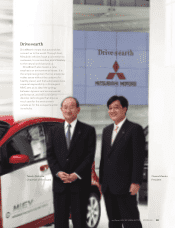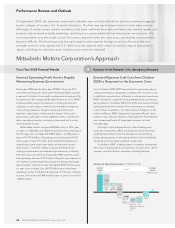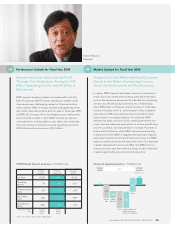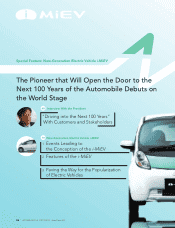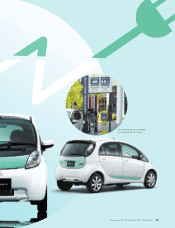Mitsubishi 2009 Annual Report Download - page 13
Download and view the complete annual report
Please find page 13 of the 2009 Mitsubishi annual report below. You can navigate through the pages in the report by either clicking on the pages listed below, or by using the keyword search tool below to find specific information within the annual report.
Fleet Tests Under Actual Driving Conditions With Electric Power Companies and Other Partners
Heading toward market launch, in addition to repeated internal testing, MMC conducted joint research with
several Japanese electric power companies to confirm the i-MiEV’s acceptability as a commercial vehicle for
electric power companies, which are envisioned as fleet customers. These fleet test runs are also aimed at
checking the vehicle’s compatibility with the quick-charge stations being developed by electric power compa-
nies and assessing the vehicle’s utility under various conditions in various regions of Japan. MMC is also putting
the i-MiEV through a wide array of other test programs, including fleet tests in police duties with Kanagawa
Prefecture, proving tests with Japan’s Ministry of Environment, and evaluations by Japan Post Service Co., Ltd.,
Lawson, Inc. and other companies.
MMC has made steady progress toward the development of a production model based on data obtained
through fleet tests conducted under various usage and weather conditions.
The Pursuit of Safety
The high-voltage system, battery pack included, is located inside the i-MiEV’s body frame and is further pro-
tected by a well-crib frame and under cover against damage from bumps in the road surface and from any
direction of impact.
The MiEV OS (MiEV Operating System) integrated vehicle management system constantly monitors battery
status, ensuring safety by cutting-off high-voltage circuits when alerted to a collision, electrical leakage, or other
incident. The advanced management system uses sophisticated integrated control technologies to control the
energy recovered from the regenerative brakes while regulating output to ensure smooth and powerful accel-
eration from a full stop. As a result, the system minimizes energy consumption while delivering driving perfor-
mance that is comfortable, safe, and reassuring.
2006 2007 2008 2009
Inverter Combination meter
Permanent magnet
synchronous motor
On-board charger
DC/DC converter
Battery management
unit A/C & heater
Lithium-ion battery
(Drive battery)
Inputs from
the following ECUs:
•Airbags•ABS
•ETACS
Driver inputs:
•Shiftselector
•Accelerator
•Brakes
Tokyo Electric Power, Chugoku Electric Power, Kyushu Electric Power,
Hokkaido Electric Power, Kansai Electric Power, Okinawa Electric
Power, Hokuriku Electric Power
Tokyo Electric Power, Chugoku
Electric Power, Kyushu Electric
Power
Joint research, fleet
testing with power
companies
Market launch (Japan)
Roadmap to commercialization
Advance research
Joint research
Fleet testing
MiEV OS
(MiEV Operating System)
Safety &
Reassurance
Battery management system
High-voltage control system
Available range estimation
Traction control
Regenerative braking control
Power save control
Smooth acceleration control
Residual battery charge
estimation
Energy
saving
Occupant
comfort
EV-ECU:
•Batterymanagementsystem
•High-voltagecontrolsystem
•Availablerangeestimation
•Tractioncontrol
•Smoothaccelerationcontrol
•Residualbatterycharge
estimation
•Regenerativebrakingcontrol
•Powersavecontrol
11
Annual Report 2009 MITSUBISHI MOTORS CORPORATION




